- Gardening adventures, Heirloom Plants, Permaculture and Edible Forest Gardening Adventures, Planting, Recycling and Repurposing, Seeds, Soil, Varmints, Vegetables
Corn Stalks as Pea Stakes

Our corn grew to a ginormous 10′ height this year in our raised pallet beds. The roots of corn are very sturdy; we usually cut the stalks above the roots, and allow the roots to stay in the ground to decompose. Often they are there a year later, still holding the soil.

Miranda being consumed by corn and zucchini. As it is October and, despite the 95 degree F. temperatures and hot, dry Santa Ana winds that are so typical of Fall here in Southern California, it is time to plant winter crops. Peas are the top of the list to plant. There are many types of peas. Some are valued to be eaten as pods when the peas inside haven’t matured. Some – and these are my favorite – produce juicy round peas that can be shelled and frozen for use all year. Some produce a lot of tendrils, and these along with the new leaves and shoots are eaten in salads and stir-fries, and are very attractive. There are also cowpeas, which are really beans that enjoy warmer weather, so not a candidate for winter crops. Best of all, peas and the rest of the legume family set nitrogen in the soil. They have a symbiotic relations ship with certain bacteria that must live in your soil for this to happen. The plant harvests nitrogen out of the atmosphere, and stores it in nodules on its roots. When the roots die, either from the plant being cut back or dying, the nitrogen is released into the soil in a plant-usable form. No need for chemical nitrogen fertilizers.

King Tut peas are good eating before and after the peas form in the pods. The peas are green. 
King Tut flowers are gorgeous. One of the problems I’ve had growing the tall peas is having the best supports for them, especially in raised beds. I never seem to have tall enough posts, or the posts fall over and chaos ensues. This year we decided that we’d already grown our pea supports: our corn.
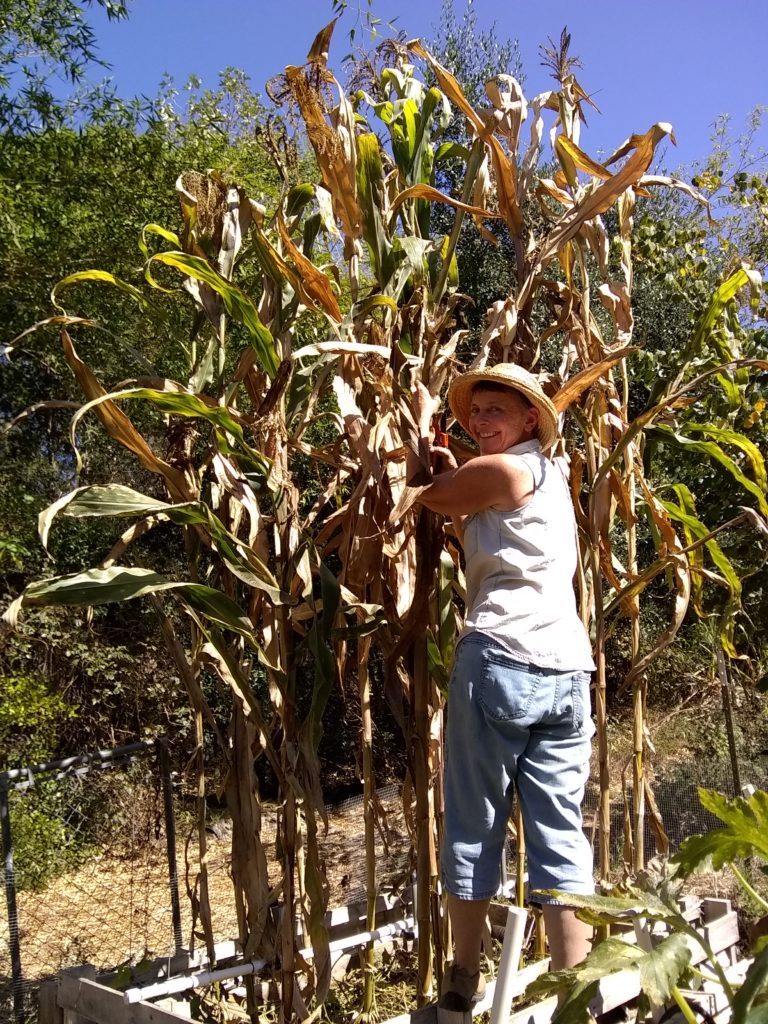
Trimming a few feet off the corn. I’m 5’3″ tall, for comparison. I have a phone in my back pocket and my pants are loose, so please don’t think I’m that saggy! We cut the corn stalks down to about 8 feet; above that the stalk was a little weak, and the stalks would be tall enough for our purposes. Then we planted vining (not bush) peas in and around the base of the corn. We had a lot of success with King Tut peas last year, which had beautiful purple pods (but green peas), so we opted for more of these in this bed.

Miranda planting around the corn. We left some of the cut sweet potato vines we’d just harvested from this bed to help hide and protect the pea seeds, and to return nutrition back into the soil. Now the peas are growing rapidly, and we’ll be able to train them up the sturdy, straight corn stalks with the help of some twine. When the peas are done, we can either use the stalks all over again for another climber, depending upon how they last over winter, or we cut the corn and the pea plants at the surface of the soil and put the whole pile into a compost pile, or into another raised bed. Corn is a hungry plant, so the pea’s nitrogen-fixing capability will help restore fertility to that raised bed. Remember that we use no fertilizer other than in-bed composting using kitchen scraps, plant cuttings, manure from our hens, and leaves, and anything else that will decompose. The beds are being watered by salty well water, too.

Baby peas are shooting up quickly. To help deter mice we sprinkle red pepper flakes over the seeds, and Miranda makes up a spray bottle full of hot sauce and water and sprays the beds in the evenings.
Re-purposing is so fun, especially when the result is better soil, healthier plants, and less work for us!
- Compost, Gardening adventures, Hugelkultur, Permaculture and Edible Forest Gardening Adventures, Soil, Vegetables, Worms
Lazy Composting
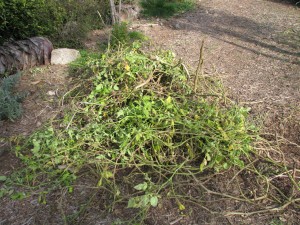
Tomato vines… what to do? I have a Rubbermaid compost bin where I dump my kitchen scraps, and a nifty three-bin pallet compost bin for larger stuff, as well as wire cages where I’ve heaped tough weeds and vines.

My wire bins floweth over. All of these methods of composting are great. They also require some physical work that I’m wary of these days. I still keep my old raised veggie beds lined with chicken wire and use them for controlled or experimental crops and extra seed. The soil in them settles after awhile and because I don’t turn my compost heaps enough I don’t produce enough compost to haul over and refill the beds.

Soil is at a low level in the raised beds. Today I decided to try mini hugelkultur beds. Hugelkultur is the practice of heaping wood and other organic matter, covering it with soil and planting directly on the pile. The berm catches water and the buried wood holds the moisture, releasing it slowly to the plants and gradually decomposing to create beautiful soil. When I planted my strawberry bed two years ago I buried old lime tree logs all along the edge. Now that soil is beautiful as the logs decompose, helping to acidify the soil for the acid-loving strawberries, and holding moisture by the roots. Some strawberry plants have rooted right in the logs.

Strawberries have rooted runners directly into the rotting lime logs. The soil around the logs is perfect. In one of my long raised veggie beds I cleaned out the frosted tomato vines and what sweet potato vines were left after our harvest.

Frosted tomato vines: treasure, not trash! I don’t like to disturb the soil because that kills microbes, fungus and worms, but this soil hadn’t been perfect to begin with.
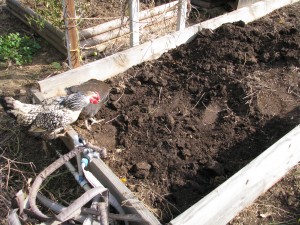
Digging up the soil and trying to protect the worms from the persistant chickens. I shoveled out a portion of the soil then cut up the tomato vines and dropped them in the bed.
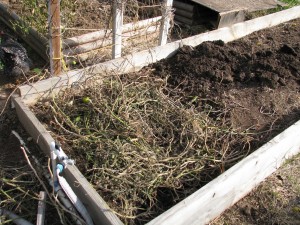
Heaping on the vines. Then I shovelled the dirt back over again, and made my way down the bed until all the vines had been covered.
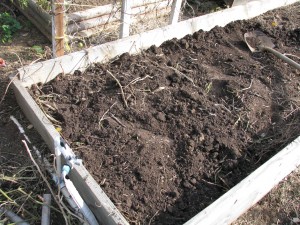
A few vine ends stick up, but that’s okay. If I had more soil I’d bury them more. I also sprinkled on sugar and epsom salts, to feed the microbes and add magnesium (I’ll blog about these two garden wonders another time).
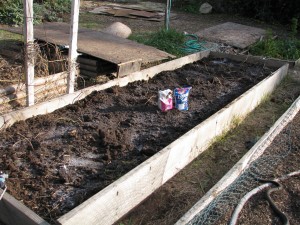
Magnesium-rich epsom salts and sugar (organic molassas is better) invigorate the soil. Burying garden leftovers like this does several things. It quickly feeds the microbes and worms in the soil without the critters having to gnaw on them from underneath or wait until the plants decompose more. The vines keep the soil from compacting and help hold moisture when it rains.

I cut the tomato vines and leave the stem and roots. Worms love roots. The vines had taken nutrients up into the leaves and fruit, and now many of those same nutrients are being returned to the bed in which they grew. Keeping the soil moist from underneath is a valuable way to protect seedlings from bugs. Top mulch I have found to be a nursery for damaging pill bugs, which you might call ‘rolly-pollies’ or sow bugs.
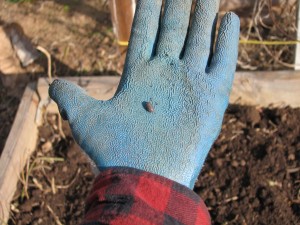
A sow bug on my glove (No, I’m not a Smurf). Although experts say that sow bugs don’t directly damage plants and fruit but rather feed off of already damaged produce, I have my doubts. If so, I believe that mine hired another bug or bird to damage about half of my strawberry crop last year so that they could feast on them.
Because decomposing green matter will initially take nitrogen from the soil, I’ll let this bed sit for a couple of months before planting, or if I can’t stand to wait I’ll plant nitrogen-fixing peas as a cover crop. I won’t repeat the same crops in this bed because it is smart to rotate families of veggies for many reasons, including pest control. Whatever I put in here, however, will be a mix of seeds.

I spy a sweet potato that hid the harvest by growing under through the wire and under the board! Another bed I’ve been playing with had been empty and needed soil. Over the last season I’ve thrown in garden debris and a layer of llama poo topped with sweet potato vines. Last week I balanced a piece of plywood over it. Today I took a peek and the vines are covered with bugs decomposing in the moist darkness of the plywood as the heap gradually settles. I’ll leave it be and keep checking on its progress.

Plywood balanced on piled garden debris I have more lazy composting ideas for the entire property. I’ll let you know.